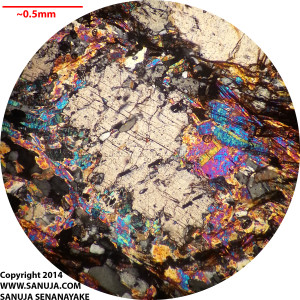Thin section sketches are drawings that represent what you observed. But most of us (students, researchers and professors) are not artistically inclined. Even if you are good at drawing diagrams, you still have to empathize key features when drawing a thin section sketch. Here are some tips and tricks for making a good (if not perfect) thin section sketch.
I. Microscope scale and polarization
Rarely a thin section is drawn with both PPL (plane polarized light) and XPL (cross polarized light). Thin section sketches should be drawn in one type of polarization. Depending on the mineral assemblages in the sample, choose the polarization that shows the best detail and most features. Generally the sketches are made in XPL. But this is a rule or may not work for every sample. For example, if you have a thin section with very strong differences in relief between the minerals in PPL but similar features (for example, all isotropic) under XPL, it is best to use a PPL sketch.
Do not switch between powers (lenses) on the microscope during the sketch. Choose the power that best suited for the size of minerals and features and record it beside the sketch. You should also include a scale measuring from one end of the diagram to the other. When drawing by hand I found that it is a waste of time to reduce the scale bar. I rather draw the scale bar across the entire sketch.
Key points:
1. Draw the thin sections in either PPL or XPL, not both.
2. Choose a magnification that is best suited for the size of minerals and petrologic features.
II. Drawing
It is almost impossible for a mineral to grow by itself. Minerals are attached to either the matrix or other neighboring minerals. So if you are making a sketch of a specific grain, make sure you also draw the surrounding (even if it is just glass).
In order to show relief try the following; if the grain has a strong relief compared to the surrounding, thicken the border of that grain by drawing the grain boundary over and over. If the grain has a low relief use less pressure on your pencil when drawing the grain. Use common sense to draw everything in between the highest and the lowest relief. Remember, you can have two grains with very high relief next to each other. But in order to identify that you must have lower relief minerals surrounding those grains.
Yes, you may cheat a bit on your drawing. While you should always draw only what you can see under a particular field of view, sometimes not all features can be captured in a single view. In this case you have two options; drawing two different diagrams or adding features to the diagram you have that you found in other areas of the slide. To do this, you need experience to make and educated decision so that you do not fabricate any textures or features.
Key points:
1. Draw what you see! Nature has it’s own rules such as mineral by itself in a thin section is rare.
2. Pay attention to detail such as relief.
3. Sometimes you have to add addition features from other parts of the slide to your sketches in order to show all the features in one diagram. Use educated decisions on such cases to avoid fabrication of information.
4. Use good pencils and erasers. I have seen some students just smudges their paper trying to correct diagrams.
III. Labeling
To make it neat, place the labels to one side or limit writing the labels on all sides. If your scale is for the entire field of view, makes sure the scale bar do not cut across your labels/ It is also better to use conventional abbreviations for minerals. For example, Hbl – Hornblende, Qtz – Quartz, Grt/Gt – Garnet, Cum – Cummingtonite etc. For a complete list, please consult British Geological Survey mineral list document.
Avoid labeling the same mineral more than once except when a different form of optical properties are shown. For example, you may label Hornblende both at extinction and without extinction. But do not label Hornblende in one form (non-extinct for example) more than once.
Instead of using arrow, use lines. This will avoid obscuring the what mineral or features you are highlighting.
IV. Presentation
Finally, what ever you draw make sure that the next person who look at your sketch can intemperate what you are trying communicate. There is no point of drawing a thin section sketch if no one can understand what you are drawing. If there are additional information on the sample (such as location, series number, etc) write that on the corner of your sketch. This will not only help others, but also will help you for future references.

